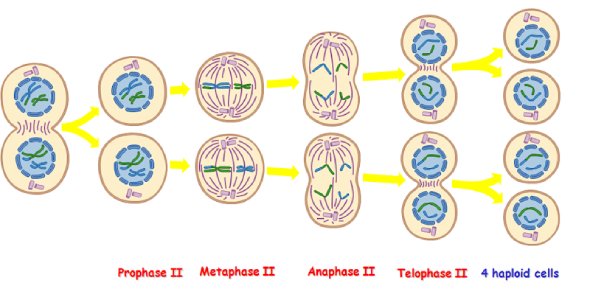Purpose of Meiosis
Introduction
Meiotic Cell Division occurs exclusively in reproductive cells and consists of the process of meiosis followed by two cycles of specialized cell division which are similar to mitosis but not the same. The end product is four progeny (daughter) cells, each with half the number of chromosomes of the parent cell.
Learning
Why do some cells undergo the process of meiosis? The purpose of meiosis is to produce gametes (sperm and egg cells) important for organism’s that perform sexual reproduction. When gametes are joined through sexual reproduction, genetic traits from two separate parents are combined to generate a new offspring. We will explore the principles of genetic inheritance in the next unit.
Diploid vs Haploid
The key to understanding meiotic cell division is to realize that most animal cells contain two copies of each chromosome – one received from each parent – a situation referred to as ‘diploid’.

The two chromosomes in each pair are referred to as ‘homologous’.
When we look at the process of meiotic cell division, it will become apparent that while meiosis is similar to mitotic cell division, the end product is distinctly different. Recall that the goal of mitotic cell division is to produce 2 identical, genetic clones (progeny/daughter cells) from a single parent cell. To accomplish this, mitotic cell division involves one round of DNA replication followed by one round of cell division.
In contrast, the end product of meiotic cell division is to produce 4 genetically different progeny, each containing exactly ½ the chromosomes of the parent – a situation referred to as ‘haploid’. To achieve this, meiotic cell division involves one round of DNA replication followed by two subsequent rounds of specialized cell division (meiosis I and meiosis II) as shown in the diagram below.
It is through the process of meiosis that much of the genetic variation that exists between individuals is generated. We will discuss this in greater detail during the unit on Inheritance.

Summary
- The end-product of meiosis is the production of (4) haploid gamete cells (sperm or egg) for sexual reproduction.
- The haploid gametes each contain only one copy of each chromosome.
- These gametes can be fused together (fertilization) to generate a new, diploid organism.
- Meiosis creates much of the genetic variation that exists between individuals.
Sources:
“Meiosis.” By The Biology Corner. Retrieved from https://www.biologycorner.com/bio2/notes_meiosis.html /_Licensed under: CC-BY: Attribution